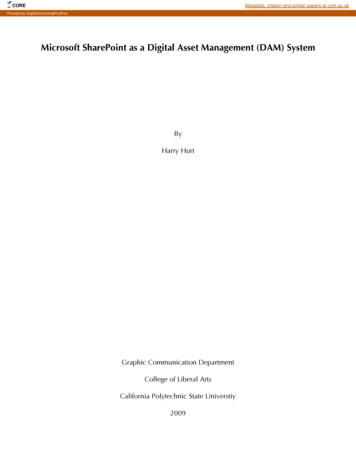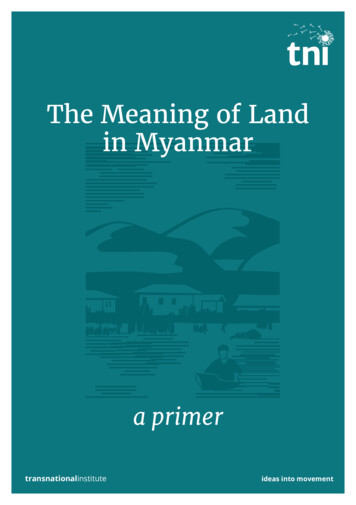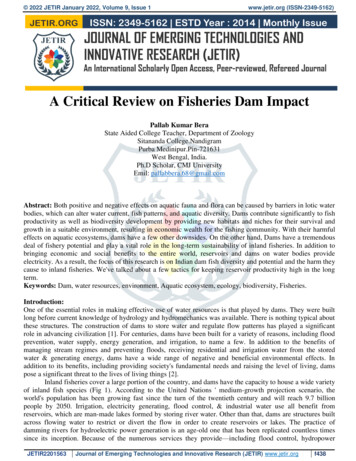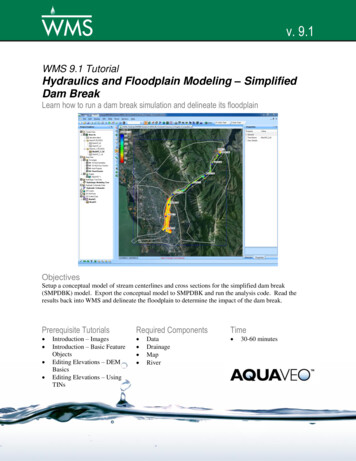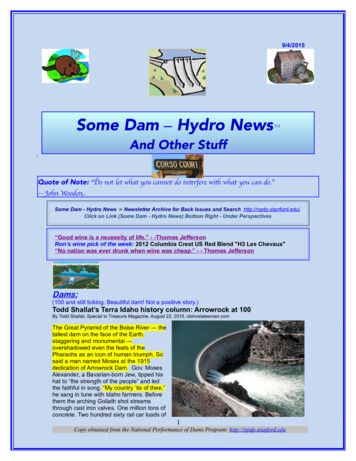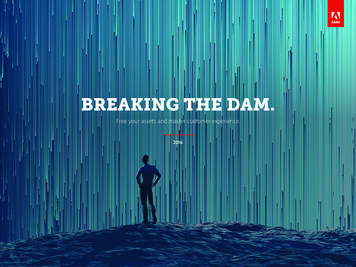
Transcription
BREAKING THE DAM.Free your assets and master customer experience.2016
TABLE OF CONTENTS68911131416172016 Breaking the dam.Remove walls between creatives and marketers.Create unified campaigns across your systems and channels.Make it drop-dead easy for your partners, channel, or anyoneto share your assets.Make asset personalization easier for marketers.Distribute digital assets with the highest quality possible.Make its easy for people to get the right assets.Tap into your audience for the most impactful content.Monitor how digital assets are used and perform.2
Your effectiveness at creating, sharing, and deployingrising deluge of assets that need to be created, stored,creative digital assets has a direct impact on yourand shared, old-world DAM systems soon reach orability to create compelling customer experiences. Andhave already reached their breaking point.digital asset management (DAM) is the foundationalpiece in that effort. But be careful. There’s danger inthe attitude, “We have a DAM. We have things undercontrol.” The world was a very different place threeor four years back when many of the DAM systemsused today were built. Back then the Internet of Thingswasn’t even a thing. Those old-world systems weren’tdesigned with the explosive growth of today’s digitallandscape in mind.The constant evolution of digital marketing continuesto expose deficiencies and gaps in old-world DAMsystems and the way organizations deal with theirassets. The realities of today’s digital world require anew kind of DAM system—one that eliminates assetbottlenecks and helps fix the way assets and contentmove through organizations and their channels. Youneed a next-generation DAM system that works withsupporting technologies to make it easier to giveCertainly, old-world DAM systems can keep assetsyour customers personal digital experiences that leadsafe and give you a central place for your people toto more sales, greater loyalty, and higher ROI. Yourget your assets. But like a dam across a river, theseorganization needs a way to free up its assets so theyoutdated systems can become bottlenecks in yourcan go to work for you.organization’s digital marketing efforts. They can holdyour team back instead of helping you keep pace withthe demands for efficient asset creation, collaboration,and distribution. Rather than scaling to handle the fast-2016 Breaking the dam.3
Your next-generation DAM system should also beYour DAM system should be the foundation on whichable to help you address other issues that hold youthese improvements are built, but remember, it’sand your asset sharing efforts back. Communicationa make-it or break-it deal. If you get it right, you’llproblems between departments. Disconnects betweenposition your business to move far ahead of thecreatives and campaigns. Breakdowns in asset deliverycompetition. If you misstep, you’ll be left behind. Andto the sales channel. The complexities of trying to usegetting it right requires a next-generation DAM system,assets for different screens and different connectionplain and simple. In this paper, we’ll look at why.speeds. A next-generation DAM system should beable to help you open up the different processes andsystems that can block the flow of assets.A true next-generation DAM system goes wellbeyond basic asset sharing and creation. It plays apivotal role in shaping your digital marketing strategy.For example, one study shows that organizationsthat consciously invest in holistic improvements totheir digital marketing program see a bigger payoffthan those that take a one-off approach to digitalstrategies and tactics.12016 Breaking the dam.4
Enterprise Asset Sharing Best Practices.WORKFLOWRemove walls betweencreatives and marketers.PAGE 6CAMPAIGNMANAGEMENTANALYTICSMonitor how digital assetsare used and perform.Create unified campaigns acrossyour systems and channels.PAGE 17PAGE 8DAMCHANNELSMake it drop-dead easy for yourpartners, channel, or anyone toshare your assets.Digital Asset ManagementPAGE 9The right DAM can solve manyof the problems in the marketingand enterprise asset environment.SOCIALMARKETINGTap into your audience forthe most impactful content.PAGE 16METADATAPERSONALIZATIONMake its easy for people toget the right assets.Make asset personalizationeasier for marketers.PAGE 14PAGE 11RESPONSIVEDistribute digital assets with thehighest quality possible.PAGE 132016 Breaking the dam.5
REMOVE walls between creatives and marketers.The way you support creativity has a directrelationship on your profitability. One Forrester studyindicates that companies that foster creativity enjoygreater market share by a factor of 1.5 comparedto their less creative counterparts.2 A differentstudy shows that design-driven companies haveoutperformed the S&P 500 by 219% over 10 years. 3But encouraging this kind of creativity doesn’tnecessarily come easily. Some of the biggestobstacles are simply the walls that get built betweenmarketers and creatives that make it difficult for themto work together.Some of those walls get built when marketers have towork with many different creatives and creative teams.You might have your own internal creative team aswell as relationships with a dozen different creativeagencies. Different types of walls get put in place if youdepend on a single large creative agency to handle2016 Breaking the dam.much or all of your work. From project kickoff to allthe back-and-forth to final approval, it’s difficult foryour marketers to collaborate with all your creatives.This not only impacts your ability to meet all of yourimpossible deadlines, but it has a significant impact onthe quality of your finished creative work.When you don’t have efficient processes in place, youblock the collaboration efforts between marketersand creatives while slowing the time it takes to createcompelling user experiences. That’s especially truewhen those efforts rely on email, file shares, FTPservers, file sharing services, and even old-school DAMsystems that use time-consuming, awkward, andmanual processes for sharing, collaborating on, anddistributing your assets.But a next-generation DAM system supports assetsharing workflows between teams and can breakdown these walls. In fact, “78 percent [of marketers]agree DAM is key for streamlining the end-to-endprocess from asset creation to campaign delivery.”4Consider, for example, the number of steps andsystems involved in your current content creationprocess. It’s probably a double-digit number, andit’s easy to see why. If marketing builds campaignsfrom assets stored in one system and the creativeteam manages and stores them in another, there’sinefficiency, and that creates a wall. A system thatcombines and streamlines the creation, feedback, andapproval processes, then, will increase the speed andease of creating and delivering consistent experiencesacross all your channels.DAM and workflow technologies that help youprepopulate assets with metadata also make a bigdifference in improving the back-and-forth betweenmarketers and creatives. If work on an asset needs6
to be reassigned to a different team member, a newstaffer, or even a different agency, asset metadata canprovide guidance to the new person that lets themquickly pick up where the previous person left off.Having a rich media data set also makes it easy tofind the right asset in the first place, which is critical.Seventy-one percent of marketers say they need tocreate 10 times as many assets these days to supportall the different channels, so searching this growingmountain of assets is much easier if you have theright metadata.The combination of metadata and workflows caneven help you make sure teams and partnersuse assets within the terms of licensing rights. Forexample, if someone on your team tries to initiatea project that intends to use a celebrity image in asocial media campaign, but you only have rights touse that image on your website, the system can warn2016 Breaking the dam.your team member immediately. It can even ask theteam member if they want to automatically initiatea process to try to obtain the necessary social mediarights. As such, not only are these examples of buildingintelligence into workflow processes importantfor efficiency, they can also stave off the huge riskdownstream from potential legal actions caused byusing an asset in the wrong place or at the wrong time.Simply put, the combination of a next-generation DAMsystem with intelligent workflows opens up the way formarketers and creatives to work together. Interactionsare simplified and streamlined. Everyone enjoys moretime for creativity. All aspects of the asset creationprocess run more smoothly. You put yourself in theposition to create better user experiences and respondfaster to valuable new opportunities.“78%agree DAM is key forstreamlining the end-toend process from assetcreation to campaigndelivery.”57
CREATE unified campaignsacross your systems and channels.When you invest in the creation of an asset, youobviously want to get the most value from it. To dothat, you have to use it across all of your channels.Rather than thinking of your email, social, and webteams creating their own, distinct assets, think ofcampaigns as broad, customer-focused initiatives thatshare the same creative assets across all channels.Then you can start enjoying some nice benefits.The first benefit is creating greater interaction acrossall of your different teams—web, email, social,for example—regardless of their particular focus,something we talked about in the last section. Next,you create a more consistent customer experience nomatter where or how your customers interact with you.We’ll talk more about how to achieve this consistencylater in this paper. The third benefit is gaining cost andtime efficiencies that can come when you unify yourcross-channel initiatives. So, not only do you savemoney by getting the most out of the assets you create,but you increase your ability to quickly respond to thedemands of all your marketing channels.2016 Breaking the dam.Centralizing your assets across channels begins witha DAM system and workflows that can facilitate thenecessary collaboration among your marketing teams.A next-generation DAM system that takes advantageof the cloud can make access and sharing easier andfaster for different teams, no matter where those teamswork. To further unify different campaigns, the DAMsystem also needs to be able to work with other typesof marketing systems, such as those publishing tosocial, email, web, video, or other channels.“45% say DAM improves brandconsistency across campaignsand channels.”68
MAKE IT DROP-DEAD EASYfor your partners, channel, or anyone to share your assets.The easier you make it for partners, the channel, and anyone else to get your creative assets, the more likely they’lluse them to promote your products and brand. A cloud-based DAM system with an easy-to-use media portal isessential to providing that easy access.For example, international athletic equipment company ASICS had been using an asset sharing system thatslowed down its retailers’ ability to get and upload ASICS creative assets to their websites. ASICS had to individuallymanage and respond to ongoing individual requests for these assets from each of their online and physical retailpartners to support their selling and promotional efforts. And every time ASICS updated any of their products, theyhad to push out new and updated assets to each channel partner in a one-to-one fashion. This cost the retailersand ASICS time, potential revenue, and customers.To solve this problem, ASICS invested in a new DAM system that centralized all of their digital assets and allowedthem to create a self-service brand portal that automated its manual processes. The brand portal acted as a filterand a secure access point for the DAM system, giving the retail partners access only to those approved creativeassets that ASICS wanted them to use, while making it easy for the partners to find and download the assets theyneeded. Now when channel partners want to promote a certain product or run a campaign, they just log in to theASICS portal, browse its folders or perform a search to find the approved assets they need, view the different assets,and immediately download the ones they want.40K 200SKUsemployee hoursUsing a brand portal, ASICS switchedfrom manual processes to automatedones for managing 40,000 SKUs,contributing to an estimated savings of200 employee hours managing retaileraccounts and requests while improvingthe user experience.8As a result, ASICS’ retail partners are happier because it’s easier and faster to get the assets they need forpromotions. And ASICS is happier not only because their assets get to market faster, but because they save asignificant amount of time managing the user experience.72016 Breaking the dam.9
A brand portal can provide your partners and others a variety of other benefits. When you have a cloud-basedportal integrated with your DAM system, you not only provide others faster and easier access to your creativeassets, but you can better secure your sensitive information. It lets you populate a cloud environment—separatefrom all the assets stored on your DAM system—that is a subset of your creative assets—a subset that only has theassets that specific groups of people need. That limited visibility and access to only the assets that certain partners,channels, or other groups need also eliminates asset clutter and overload, making it even easier for them to findthe most appropriate assets to use.Another major benefit a brand portal can give you is the ability to ensure brand integrity across your channel ina way that reinforces your brand and enhances the customer experience. Outdoor patio furniture manufacturerTropitone realized this as they created a portal for their dealers and sales representatives. This brand portal hostsvignettes of all the company’s furniture options, which can display on demand unlimited variations of any asset.Using the asset’s original imagery stored in the DAM system, portal users can change the size, format, resolution,cropping, or effects of an asset. They can zoom in, pan, swap color swatches, and show different fabrics and stylestoo. This makes it easy for dealers and representatives to tailor the visuals in their sales presentations to the specificneeds of any customer, while allowing Tropitone to maintain a consistent brand image.9Overall, brand portals make it easier for anyone internal or external to your organization to engage in marketingefforts for you. This includes even indirect marketing efforts. For example, public relations teams can create a mediaportal for the press to make it easier for them to use approved creative assets in news stories and articles thatreference your organization.2016 Breaking the dam.10
MAKE asset personalization easier for marketers.Customers crave engaging digital experiences. Theywant emotional connections. So it’s imperative togive them personal experiences that match theirown individual needs and tastes, whoever andwherever they are. The demand for these personalizedexperiences not only continues to rise, but it’s fastbecoming a consumer expectation.Today, the level of complexity only increases as thecontent driving those experiences needs to be just asengaging whether the experiences are happening oncustomer smartphones, tablets, laptops, digital signs,digital watches, or digital whatevers. But having theright technology in place can simplify and significantlyreduce the cost of your personalization efforts.For example, a recent Accenture web survey foundthat 60 percent of customers want to receive realtime offers in stores, and 59 percent would likeoffers delivered while they’re considering productsonline.10 But a survey conducted by Econsultancy, inassociation with Adobe, shows that only 5 percentof marketers currently use technology to personalizeextensively. And 29 percent say they aren’t practicingpersonalization of any kind.11 To make matters worse,of the customers who say they’ve had personalizedexperiences, 70 percent called them superficial and63 percent said in addition to not being compelling,they were annoying.12Next-generation DAM systems facilitate marketers’decisions and efforts around personalizing assets.They work with or incorporate new personalizationtechnologies that let you cost-effectively and easilybuild personalization into core asset processes. You canautomatically render unlimited variations of a singlecreative asset to generate personalized experienceson demand. With a collection of master images, textlayers, color palettes, customer data, asset metadata,and business rules, you can assemble and recouplepersonalized content on the fly across mobile devices,websites, digital signs, kiosks, and more.As those statistics illustrate, personalization can beextremely difficult for marketers, not to mentionexpensive. In the past, personalization requiredlong lead times, working with an army of creativesto produce in advance all the needed variationsof assets for every possible personalized scenario.2016 Breaking the dam.For example, you might want to place a banner adwith a holiday theme on your site. With personalizationtechnology tied into your core assets, your ad doesn’thave to display a set product or promotion. The actualproducts and promotions displayed in the banner candynamically change, giving you flexibility in what youpromote and when. Instead of having a static bannerthat might experience mediocre click-through, this letsyou personalize it by individuals or customer segmentsbased on their recent purchase history, what theyhave in their cart, or other pages they visited. So, ifa certain shopper spent time on a web page for aspecific running shoe on your site, your personalizationprocess can dynamically create a banner that displaysthe shoe image with a relevant offer as part of yourholiday campaign.Technology like this integratedwith your DAM and contentmanagement systems lets youuse what you already know aboutyour customers to dynamicallycreate more meaningful onlineexperiences for each one.You can also let customers drive the experience, usingconfiguration tools to design the features and look ofproducts to their tastes, whether it’s customizing theirown shoe, car, living space, or whatever.Going back to the running shoe example, you couldhave a configuration tool on your website that givesshoppers a virtual showroom where they can designand create their own personalized version of a shoe11
they want to buy. You present them a set of controlsthat make it easy to modify the default design of ashoe by changing things like color, patterns, fabric, orwhatever parameter you define until the shopperscome up with combinations they like and want tobuy. This gives consumers greater control and buyingconvenience that promotes a much richer and morepersonal experience.This is what Tumi does. This upscale manufacturer ofluggage, briefcases, and bags uses a personalizationengine in conjunction with their DAM system toallow online customers to see their bags in any coloror fabric offered, as well as to create and preview inreal time custom monograms on those bags. Usinga single master image and color and fabric samples,they can render all the different product-colorcombinations and font styles with previews that showdetails such as stitching and curvature with pictureperfect accuracy.13wider array of products, including a fuller selection ofcolors, styles, sizes, and personalization options, thana physical store. Even look at migrating aspects ofthat personalized digital experience to the storefrontin interactive kiosks or digital signs that change asdifferent customers approach.Whatever your product or service, personalizationhelps your customers feel a deeper connection withyour brand and offerings. That ultimately leads tohigher conversion rates and sales. And when you havea next-generation DAM system that makes it easier totake advantage of new personalization technologies,you can significantly reduce your asset developmenttime and effort, saving you money while giving youfaster time to market.66%Survey respondents whoautomated personalizationfor mobile achieved a 66%increase in mobile conversionrate above the average of thosewho didn’t personalize.14One of the goals of personalization is to not simplybring the in-store experience to your customers’digital devices, but to make digital experiences evenbetter and more engaging than traditional in-storeexperiences. Let users shop at their leisure, exploreyour offerings in greater detail, and get more familiarwith your brand. Create an online store that offers a2016 Breaking the dam.12
DISTRIBUTE digital assetswith the highest quality possible.To fully engage with your customers, you needto create positive experiences across the entirecustomer journey. Even if you make a great emotionalconnection with customers while they browse fromtheir office laptops, you’ll lose them if the experiencedegrades when they try to continue shopping fromtheir tablets or smartphones. You need consistentcustomer experiences that are agnostic when it comesto device type and screen dimensions. You need to beable to ensure asset quality and fidelity everywhereyour customer connects with your brand.Creating consistent experiences across all of yourcustomer touchpoints is just as tricky as personalizingyour communications, and for similar reasons.Developing assets and customizing the experience forevery possible screen shape can be cost-prohibitive.But also similar to personalization, next-generationDAM systems can use dynamic asset enablementtechnologies that eliminate the need to createdifferent versions of your assets for every channelyour consumers might use. No matter what deviceor format your customers use, these technologies let2016 Breaking the dam.you deliver a consistent experience by convertingassets on the fly to meet the requirements of a specifictouchpoint destination.Such a scenario typically starts with storing one veryhigh-quality original version of each asset in your DAMsystem. With your DAM system driving dynamic mediaserving, you can automate the process of correctlyrendering and sharing this original asset in real timewith the best possible experience for any given device.This process allows you to create rules and templatesin advance, identifying the best default sizes for eachdevice and screen. Then, as different channels anddevices request that asset, the optimal experienceis created and delivered from the single source. Thisallows you to use the same base image for print, video,web pages, tablets, and smartphones without havingto store and manage separate versions and sizes. Thusyou create consistent experiences with a single coreasset across all devices, channels, and connectionspeeds without having to create and manage nearlyunlimited versions of an asset.While dynamic asset enablement incorporates aspectsof responsive design, it goes beyond that. It’s aboutgetting assets to seamlessly support multiple devices. Itlets you share a single asset with different devices anddynamically adapt it to the needs and features of eachdevice. It does more than just modify the asset for size.It also has the intelligence to modify and optimize theasset for the device’s connection speed, pixel density,formatting, and even image cropping.13
MAKE IT EASY for people to get the right assets.If you’re like many enterprises, you might have millions of creative assets to manageat any one time. Enabling all your different marketers, creatives, channel partners, andeven the press to find and then use the right assets can be a difficult, time-consumingchallenge. You don’t want to give them access to everything, but you want to makesure they can easily get what they need. You can make the right assets easily accessibleto the right people and systems by using metadata in your next-generationDAM system.Metadata is simply data that you tie to an asset to describe what it is. If you have aphoto of a vintage sports car built in 1967, the metadata for that photo would notonly indicate that it’s a photo of a 1967 vintage sports car, but it should state thecar manufacturer, car model, color, and perhaps other details such as chrome trim,upholstery, wheel type, and engine. But to be entirely useful, the metadata doesn’tstop there. It might have information on where the photo was shot, the backgroundscenery, the name of the photographer, copyright information, and particularlyimportant, what licensing rights you have in terms of using the photo.To help ensure that proper and complete metadata gets tied to each of your assets, youwant a next-generation DAM system that helps automate the process of populatingthe metadata. As a basic example, rather than having to manually add campaignspecific metadata to each asset in a campaign, you just enter the metadata once, andthe DAM system automatically populates that metadata on the appropriate assets. Amore advanced scenario would be a level of asset intelligence that can scan imagesin the DAM system to see if they’re missing obvious tags that the digital fingerprintof the image files says they should have. Such tags might include things like people,landscapes, cars, devices, phones, computers, animals, belts, purses, and even thecolors of all these items. The DAM system would be able to automatically detect thesegraphical elements and add their associated meta description tags if they are missingand considered useful by the marketer.In addition to details that describe the asset, your metadata should also describehow you initially intend to use the asset, as well as other ways it might be used. Forexample, you could specify that it’s initially for a fall 2016 campaign, which couldallow your DAM system to automatically serve the asset to channel and mediatargets for that campaign. To help with other potential use cases, you could includemetadata that indicates that the asset resonates with car enthusiasts or malesbetween the ages of 45 and 65.2016 Breaking the dam.14
These types of meta tag automation and assetintelligence can also help make sure your assets areautomatically delivered to the channels and campaigntargets you want. This makes it easier for your internalteams and external partners to find the relevantcreative assets they need.Similarly, you can apply metadata to assets, inconjunction with your DAM system’s workflowbusiness rules, to help enforce licensing restrictions.Well-structured metadata can also enable dynamicpersonalization and consistent experiences across allof your customers’ touchpoints.As a best practice, your metadata should supportthe Extensible Metadata Platform (XMP) standard.This allows the metadata embedded in your assetsto be recognized and used by other systems andapplications outside your organization. Your systemshould also have an open API or be preintegratedto connect to enterprise systems such as webcontent management, commerce systems, orother business applications.76%say DAM eliminatesdifficulty finding assets—and thus time spent recreatingassets that already exist.”15“You have to have a strong and dynamic brand, but alot of organizations don’t even know where all theirassets are, what they’ve done with them, and if they stillhave the right to use them. Because of that they don’thave the ability to respond with the proper velocity intoday’s market. Adobe gives you the tools and processesyou need to deliver and execute.”16IRA LESSACKVice President of Client Services3 SHARE2016 Breaking the dam.15
Tap into your audience for theMOST impactful content.As you strive to create digital experiences that resonate with your customers, you mighthave a significant hole in your strategy if you rely only on in-house developed assets.You need to leverage the best available assets wherever they happen to live. And thosebest assets might just live where your target audience lives—on social media.When your customers buy your brand, it often becomes the topic of their socialmedia conversations. These conversations can be more authentic and moreengaging than any content you could ever create because they’re born from realengagement with real people. In fact, 83% of consumers say they completely orsomewhat trust the recommendations of friends and family. But trust isn’t confinedonly to those in our inner circle, as two-thirds say they trust consumer opinionsposted online, which makes it the third-most-trusted form of advertising.17 Clearlyconsumers feel that the user-generated content that lives and moves through socialnetworks is more reliable and more memorable than branded content.Each day, more than two billion pieces of user-generated content get posted on socialsites. Solutions now exist that can help you find it, get the rights to use it, and thenincorporate it into your customer experiences. Being able to collect and use customercontent that complements your own brand-created content can considerably raisethe authenticity of your message with your customers, while giving those customerseven more compelling digital experiences. It can help you tap into the experiencesof real people to create memorable connections that live longer in the hearts of yourcustomers. But doing that requires a DAM system that has the ability to work withthese user-generated content solutions.2016 Breaking the dam.Opportunities also exist to actively facilitate and promote the sharing of content amongconsumers directly within your core web properties. Branded social communitiesbased around blogs, reviews, ratings, and community forums can be a powerful wayto build and promote the sharing of assets. By building sharing directly into your brandexperiences, you gain another opportunity to benefit from the highly influential andpervasive voice of the consumer. Once again, to take
creative digital assets has a direct impact on your ability to create compelling customer experiences. And digital asset management (DAM) is the foundational piece in that effort. But be careful. There's danger in the attitude, "We have a DAM. We have things under control." The world was a very different place three


